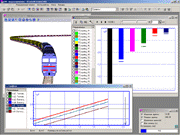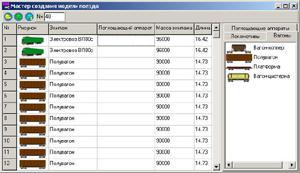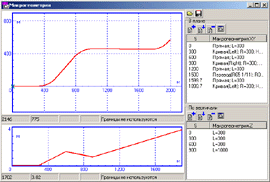UM TRAIN
UM Train
UM Train - module for train dynamics simulation - UM Train 3D - the study of spatial oscillations in composition of the train crew - Modeling technique
UM Train - module for train dynamics simulation
The module for simulation of train dynamics (UM Train) is developed in the program package "Universal mechanism". This module automates the process of train model creation and the analysis of obtained results.
The module allows computing the longitudinal dynamics of train in braking, traction and idling modes on a railway track of any configuration. Not only common variables for a mechanical system such as coordinates, velocities, accelerations, reaction forces etc but variables which are specific for a train (for example forces in intercar coupling and braking forces) are available for a user.

UM Train 3D - the study of spatial oscillations in composition of the train crew
UM Train3D module is a superstructure over the UM Loco and UM Train modules. It allows the user to create tractive connections, as well as inserting in a train any number of 3D models of rail vehicles. In particular, a train model can include a tractive connection of several cars and/or locomotives or it can be completely combined of 3D vehicle models. Our experience shows that connections of 3-5 3D models of vehicles are often used for advanced analysis of rail vehicle dynamics taking into account in-train forces at various train operation modes.
3D models of cars and locomotives must satisfy a number of requirements to be included in a train. For instance, models should include mechanical coupling systems (automatic couplers, buffers). Besides, braking mode must be provided for 3D vehicles, and traction modes for 3D models of locomotives.
Modeling technique
When creating the model it is necessary to take into account many factors such as gas-dynamic processes in an air brake system, forces which resist moving the train forward (resistance forces), various types of intercar couplings, complex track profile etc. By using the UM Train module the process of train model creation became simpler. The user points a number of railway vehicles, their types, as well as types of center coupler draft gears which are used on the corresponding vehicle. The type of a vehicle is selected from the data base of locomotives and cars. This base is open for adding a model of any vehicle. For that in the simplest way it is enough to create the graphical image of a vehicle, to set the coupled length, the mass, the resistance forces, the traction performance for a locomotive and in case of need the forces which are specific for the described vehicle.

Creation of track profile
Every vehicle of the train in terms of Universal Mechanism is a subsystem which can be a model of any complexity. Though in most cases it is enough to create a single-mass model of a vehicle, more precise vehicle model can be included in the train model to make more detailed analysis of a separate vehicle in the train.
Various mathematical models of brake systems, resistance forces, intercar couplings are contained in the module data base. In case of need models with any other characteristics described by tools of Universal Mechanism can be added to the base.
It is often necessary to analyze the train dynamics on a way with complex geometry. A special tool is developed for creation of complex railway track profile.
Since the train module is a part of the program Universal Mechanism, all tools for analysis of simulation results are available. Any kinematic and force parameters can be represented in graphical and table form. All methods of multi-parametrical and multi-criteria optimization, scanning and approximation can be used for solving problems of train dynamics.

R. Kovalev, A. Sakalo, V. Yazykov, A. Shamdani, R. Bowey & C. Wakeling
Simulation of longitudinal dynamics of a freight train operating through a car dumper
Vehicle System Dynamics, Published online: 16 Mar 2016 DOI: 10.1080/00423114.2016.1153115
Full paper (Free full access for first 50 downloads)
A heavy haul train and car dumper model was created to analyse train longitudinal dynamics during dumping. Influence of such factors as performance curve of draft gears, total free slack in couplers, operating mode of train positioner and braking of last two cars of train on the in-train forces was considered.
Dmitry Pogorelov, Vladislav Yazykov, Nikolay Lysikov, Ercan Oztemel, Omer Faruk Arar & Ferhat Sukru Rende
Train 3D: the technique for inclusion of three-dimensional models in longitudinal train dynamics and its application in derailment studies and train simulators
Vehicle System Dynamics, Published online: 11 Jan 2017 DOI: 10.1080/00423114.2016.1273532
Full paper (Free full access for first 50 downloads)
Algorithms for simulation of trains as coupled detailed spatial and simplified one-dimensional models of rail vehicles are considered. Such an approach to train dynamics allows evaluation of in-train forces and their influence on dynamic characteristics related, e.g. to the safety problems or ride comfort. Initially, the method has been developed for the analysis of derailment accidents and further it has been implemented as a mechanical solver in six-degrees-of-freedom train simulator TRENSIM, which features are discussed in the paper. An algorithm for parallelisation on multi-core processors for the simulation of rail vehicles and trains is presented.
Maksym Spiryagin, Qing Wu & Colin Cole
International benchmarking of longitudinal train dynamics simulators: benchmarking questions
Vehicle System Dynamics, Published online: 11 Jan 2017 DOI: 10.1080/00423114.2016.1270457
Full paper (Free full access for first 50 downloads)
Longitudinal train dynamics (LTD) simulations have been playing an instrumental role in the development of larger trains, especially freight trains. LTD simulators have been reported from all around the world, but without standards or standard questions to assess the correct implementation of LTD analysis and the state of LTD studies. Under this situation, the Centre for Railway Engineering initiated the International Benchmarking of Longitudinal Train Dynamics Simulators. Eight teams involving 10 institutions from five countries across three continents have participated in the benchmark and submitted their results. This paper describes the benchmarking questions so other researchers will be able to repeat the simulations in the future and benchmark their programs against the current participating software. The question information includes train configurations and characteristics of the wagon connection system, locomotive traction and dynamic brake characteristics, resistance formula, track data, train driving controls and output requirements. The question information will also enable researchers to replicate the benchmark by providing relevant formulas, data sheets, figures and descriptions.




